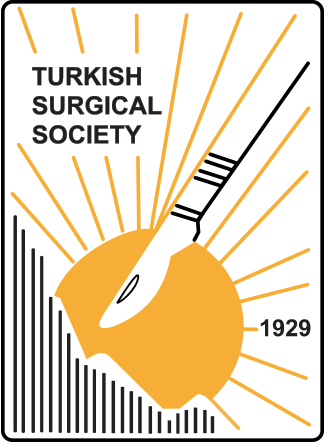Abstract
Purpose: Today, synthetic patches are being used in open or laparoscopic ventral hernia repairs widely. We have aimed to examine adhesive potentials of various patches in rats treated with laparoscopic ventral hernia repairs.
Material and Method: Rats were divided into six different groups with 8 subjects on each group: control (group 1), polypropylene (PP) (group 2), hyaloronic acid/carboxymethylcellulose coated polypropylene (PP+H/K) (group 3), expanded polytetraflouroethylene (ePTFE) (group 4), anti-adhesive collagen coated polyester (PO+AHK) (group 5) and polyester (PO) (group 6). Only laparoscopy was practiced on the rats in control group. PP, PP+H/K, ePTFE, PO+AHK and PO patches were placed on front abdominal walls of the rats by laparoscopy method. After two weeks, the rats were sacrificed. Frontal abdominal walls were opened with a wide (U) cut, adhesion force and adhesion area were evaluated. Photos of the adhesions as a result of patches were taken in all rats.
Results: Intra-abdominal adhesion was not observed in the rats of control group. Adhesion was observed in all the rats with patches. But there were differences in terms of adhesion force and area. In the other patch groups other than polypropylene, the amount of adhesions was lower (p<0.05) than polypropylene group. The adhesion observed on polyester patch was equivalent to ePTFE and composite patches. In two composite patches coated with anti-adhesive material and ePTFE, similar adhesion was observed. In laparoscopic use of PP+H/K and PO+AHK composite patches, defects on anti-adhesive layer were observed as a result of tight rolling and intra-abdominal manipulations.
Conclusion: Intra-abdominal adhesion was observed in all the patches. In laparoscopic use of composite patches, adhesions were higher probably as a result of defects in adhesive layers.
Keywords:
Laparoscopy, mesh, ventral hernia repair, adhesions, rat model.
References
1Borrazzo EC, Belmont MF, Boffa D, et al. Effect of prosthetic material on adhesion formation after laparoscopic ventral hernia repair in a porcine model. Hernia, 2004; 8:108-112.
2Heniford BT, Park A, Ramshaw BJ, et al. Laparoscopic ventral and incisional hernia repair in 407 patients. J Am Coll Surg, 2000;190:645-650.
3Langer S, Christiansen J. Long-term results after incisional hernia repair. Acta Chir Scand, 1985;151:217-219.
4Toy FK, Bailey RW, Carey S, et al. Prospective, multicenter study of laparoscopic ventral hernioplasty. Preliminary results. Surg Endosc, 1998 ;12:955-959.
5Neşşar G. Demirbağ AE. Turhan N. et al. Karın duvarı tamirinde kullanılan sentetik materyallerin karın içi organlara yapışıklıklarının değerlendirilmesi ve karboksimetilselüloz ve hyalüronik asitin etkisi. Ulusal Cerrahi Dergisi, 2001 17, 215-219.
6DiZerega GS, Hodger GD.Prevention of postoperative tubal adhesions. Comparative study of commonly used agents. Am J Obstet Gynecol, 1980 15;136:173-178.
7Luciano AA, Hauser KS, Benda J. Evaluation of commonly used adjuvants in the prevention of postoperative adhesions. Am J Obstet Gynecol, 1983 ;146:88-92.
8Baykal A, Onat D, Rasa K, et al. Effects of polyglycolic acid and polypropylene meshes on postoperative adhesion formation in mice. World J Surg, 1997;21:579-582.
9Hellebrekers BW, Trimbos-Kemper GC, van Blitterswijk CA, et al. Effects of five different barrier materials on postsurgical adhesion formation in the rat. Hum Reprod, 2000;15:1358-1363.
10Moreno-Egea A, Castillo Bustos JA, Aguayo JL.Day surgery for laparoscopic repair of abdominal wall hernias. Our experience in 300 patients. Hernia, 2002; 6:21-25.
11Malazgirt Z, Ulusoy A N, Gok Y, et al. Bioabsorbable membrane prevents adhesions to polypropylene mesh in rats. Hernia, 2000; 129-133.
12Malazgirt Z, Ozkan K, Esener R. Onarılmayan periton defektlerinin tabanındaki kas ve yağ dokusunun karın içi yapışıklıklarına etkisi. Ulusal Cerrahi Dergisi,1986; 4:11-17.
13Ustun C, Kokcu A, Malazgirt Z, et al. The effects of Ringer's lactate solution and calcium channel blockers on the postoperative pelvic adhesion formation. Doga-Tr J Med, 1992 16: 681-691.
14Moreno - Egea A, Liron R, Girela E, et al. Laparoscopic repair of ventral and incisional hernias using a new composite mesh (Parietex): initial experience. Surg Laparosc Endosc Percutan Tech, 2001;11:103-106.
15Mazuji MK, Fadhli HA. Peritoneal adhesions; prevention with povidone and dextran 75. Arch Surg, 1965;91:872-874.
16Ellis H, Gajraj H, George CD. Incisional hernias: when do they occur? Br J Surg, 1983; 70:290-291.
17Matthews BD, Pratt BL, Pollinger HS, et al. Assessment of adhesion formation to intra-abdominal polypropylene mesh and polytetrafluoroethylene mesh. J Surg Res, 2003; 114:126-132.
18Varghese TK, Denham DW, Dawes LG, et al. Laparoscopic ventral hernia repair: an initial institutional experience. J Surg Res, 2002 15;105:115-118.
19Baykal A,Yorganci K, Sokmensuer C, et al. An experimental study of the adhesive potential of different meshes. Eur J Surg, 2000 ;166:490-494.
20Felemovicius I, Bonsack ME, Hagerman G, et al. Prevention of adhesions to polypropylene mesh. J Am Coll Surg, 2004;198:543-548.
21Besim H, Yalcin Y, Hamamci O, et al. Prevention of intraabdominal adhesions produced by polypropylene mesh. Eur Surg Res, 2002;34:239-243.
22McGinty JJ, Hogle NJ, McCarthy H, et al. A comparative study of adhesion formation and abdominal wall ingrowth after laparoscopic ventral hernia repair in a porcine model using multiple types of mesh. Surg Endosc, 2005 23;8174-8179.
23Vrijland WW, Bonthuis F, Steyerberg EW, et al. Peritoneal adhesions to prosthetic materials: choice of mesh for incisional hernia repair. Surg Endosc, 2000;14:960-963.
24Leber GE, Garb JL, Alexander AI, et al. Long-term complications associated with prosthetic repair of incisional hernias. Arch Surg, 1998;133:378-382.
25Gonzalez R, Rodeheaver GT, Moody DL, et al. Resistance to adhesion formation: a comparative study of treated and untreated mesh products placed in the abdominal cavity. Hernia, 2004;8:213-219.
26Mutter D, Jamali FR, Moody DL, et al. The concept of protected mesh t auto minimize adhesion formation in intraperitoneal abdominal wall reinforcement. Preclinical evaluation of a new composite mesh. Hernia, 2000;4:3-9.
27Bellon JM, Garcia-Carranza A, Jurado F, et al. Peritoneal regeneration after implant of a composite prosthesis in the abdominal wall. World J Surg, 2001;25:147-152.



